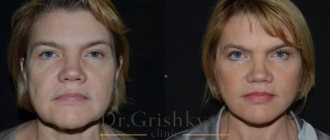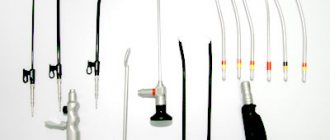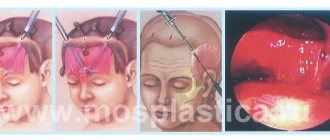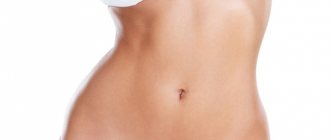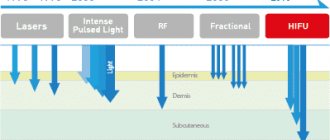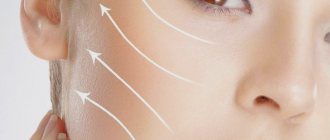The desire for an ideal appearance is normal for women. The standard is considered to be a young face with clear contours and well-defined reliefs, as in the images of the Egyptian queen Nefertiti. In order for a middle-aged woman to achieve such an appearance, she will have to try. Few manage to maintain the youthfulness of the oval in a natural way. Most often you have to turn to cosmetologists and plastic surgeons for help. There are many options for correcting your appearance. For an oval lift, a Nefertiti lift would be an excellent solution. The effect involves the correction of wrinkles and ptosis using a unique technique for introducing Botox or reinforcing threads.
What it is
Dr. Levy, a French plastic surgeon, has developed a specific technique for minimally invasive oval tightening. The technology is based on knowledge and the practitioner’s own observations. The technique is based on the principle of operation of the muscular frame. Part of the musculature is designed to lift tissues upward, the other is designed to lower tissues down.
Levi based the Nefertiti lifting on the targeted weakening of the action of the depressor muscles responsible for the downward movement of the skin. As a result of the impact, there is a compensatory stimulation of the work of the elevator muscles, which lift the tissues upward. Gravitational ptosis is regulated and the oval is strengthened.
What is Botox?
Botox is a drug manufactured in the USA, the active substance of which is botulinum toxin.
When administered locally under the skin, it causes paralysis of neural connections and muscle relaxation. Thanks to this, the drug is widely used in medical practice. In ophthalmology, Botox is used in the treatment of strabismus, in neurology - to eliminate muscle spasm. The effects caused by the drug are also used in the treatment of excessive sweating (hyperhidrosis). What Botox for the face is has also already been well studied. A technique based on the use of these products is used in cosmetology to smooth out wrinkles. Today, a procedure that involves the development of this effect is one of the most popular in cosmetology. According to statistics, more than 6 million people access it every year.
Indications for use
Nefertiti lifting is aimed at working with the lower third of the face. The tightening involves the boundaries of the oval from the ears to the chin, the neck, and the décolleté area. Lifting is recommended for those who are alarmed by the visible manifestations of ptosis:
- loss of clarity of the oval in the lower boundaries of the face;
- sagging, loose skin on the chin, neck, décolleté;
- the appearance of a double chin.
Typically, the treatment is performed on women over 40 years of age. At this age, age-related changes are clearly noticeable. According to indications, manipulations are also available to younger applicants for invasive circumferential lifting. Nefertiti lifting becomes an excellent replacement for plastic surgery.
Important! A facelift is performed for those who want to maintain fresh, youthful contours without surgical intervention. The manipulation is carried out by a cosmetologist. The lift is performed on an outpatient basis. The operation does not cause significant pain and does not require long-term rehabilitation.
Facial aging
The drooping of the tissues of the forehead, eyebrows, periorbital region and midface is the main component of age-related changes, affecting the upper 2/3 of the face. This is characterized by the appearance of horizontal and vertical forehead wrinkles, drooping of the eyebrows (especially the outer parts), movement of the skin of the eyebrows to the upper eyelid, the appearance of wrinkles at the outer corner of the eye “crow’s feet”, displacement of the tissues of the upper part of the cheek downwards, the appearance of an eyelid-buccal furrow and etc. – as a result of which the face takes on a sad, tired appearance.
The skin also undergoes characteristic changes - elastic and collagen fibers become smaller with age. Aging is not limited to sagging soft tissues and changes in the skin. The layer of subcutaneous fat under the skin in the cheekbone area becomes thinner, and in the neck area, on the contrary, it increases - the face changes its usual volume: if in youth it has the shape of an egg with the narrow end facing downwards, then with age it becomes like an egg with the wide end facing downwards.
Non-surgical facelift using botulinum toxin (Botox lifting) - relies on the primary mechanism of action of botulinum toxin - known as the result of temporary local chemical denervation of the target muscle, which causes temporary paralysis of this muscle - as a result, the skin over the muscle is straightened, expression lines are smoothed out . In addition, when botulinum toxin is introduced into the depressor muscles of any part of the face, antagonist muscles are activated, i.e. activation of the muscles that lift these same parts - due to this, lifting (lifting) of facial tissues that have sagged with age occurs. For example, with the correct injection of Botox, Dysport, Lantox into the muscles that lower the eyebrows (m.corrugator, m.orbicularis oculi), the activity of the muscle that raises the eyebrows (m. frontalis) increases, due to this the drooping tissues of the forehead and eyebrows are raised.
Thus, a facelift without surgery using Botox, Dysport, Lantox is a procedure that simultaneously “kills two birds with one stone”: it smooths out wrinkles and lifts sagging facial tissues.
Preparation for the procedure
Cosmetic intervention is necessarily preceded by a face-to-face consultation with a doctor. The cosmetologist performs an examination, talks with the patient, identifying indications and contraindications for the upcoming correction. The doctor must stipulate the conditions for preliminary preparation for the manipulation and talk about the progress of the operation.
The cosmetologist draws attention to the need to observe restrictions during the period of preparation for the intervention. 1–2 weeks before the manipulation you need to give up:
- the use of certain medications, alcohol, it is advisable to avoid smoking;
- physical activity, massage;
- cosmetic procedures (peeling, polishing, hardware, injection therapy).
It is advisable to adhere to a healthy lifestyle and organize proper nutrition. You must show up for a facelift after a healthy sleep, in a good mood, and feeling ideally well.
The riddle of Nefertiti or everything you wanted and did NOT want to know about the great queen
If you simply admire Nefertiti, and she is your ideal of beauty, then you should not continue reading. Perhaps you will be shocked by some of the details of her family life, or you may not want to see a disfigured mummy, possibly belonging to the queen. In this case, just don’t open the publication - it’s not for you.
We often don't think about the fact that Nefertiti was a real woman of flesh and blood. But neither beauty, nor wealth, nor power guarantee cloudless happiness. She went through all the trials, the ascent to power, the death of a child, disgrace, she was idolized during life, cursed and abused after death.
We will always remember her like this - a calm and beautiful face, a mysterious half-smile...
Once upon a time, many years ago, I first saw a bust of Nefertiti and was amazed by her almost alien beauty. Unfortunately, then there was little real information in the press - more and more about her husband, the famous heretic pharaoh Akhenaten (New Kingdom of Egypt, 18th dynasty, reign 1353–1336 BC). Now, after years, you and I can learn much more about it, but it is still very little. We don’t even know where and when she was born, we don’t know how many years she lived and why she died. It’s not surprising - three millennia have passed since then, papyrus scrolls have decayed, stone has crumbled, empires have disappeared without a trace, rivers have changed their courses, and the fact that we know more about Nefertiti than just her name is a miracle in itself.
She was a great queen and bore Akhenaten six daughters. We can name the names of each daughter - Meritaton, Maketaten, Ankhesenpaaten, Neferneferuaten-tasherit, Nefernefrura and Setepenra, but does listing the names tell us anything about her?
Famous painted limestone bust, Berlin Museum
Many of her statues and images decorated temples; she was often painted next to her husband, often with her family, and even defeating the enemies of Egypt - this is how only the pharaohs themselves were usually painted. She reached the pinnacle of power by the 12th year of Akhenaten’s reign, when we read about her in the inscriptions not just as the main wife, but as a co-ruler of her royal husband. Soon after this, her daughter Maketaton died of illness, and literally a year or two later all mentions of the name Nefertiti disappear. A version was put forward - the queen died during a plague epidemic. However, until recently, the main assumption was that Nefertiti simply fell out of favor with the rise of one of the younger wives of Pharaoh Kiya. Historians considered the cause of disgrace to be Nefertiti's inability to give birth to an heir.
Quartzite head - young Nefertiti
With the accession of Akhenaten's heir, Tutankhamun, to the throne, the priesthood began an all-out attack on the legacy of the heretic pharaoh. Temples of Aten were destroyed or abandoned, references to Akhenaten were destroyed, inscriptions were erased, and steles were destroyed. At the same time, the tombs of the pharaoh and his royal wife were probably desecrated or even destroyed.
Next we step onto the shaky ground of assumptions. What you will read below is not supported by all Egyptologists. The point of view is controversial, but it has a right to exist.
I inform you - the mummies of Nefertiti and Akhenaten have been found. The destruction of inscriptions on tombs and ritual objects is quite sufficient revenge from the point of view of the priests. After all, in their names there is a mention of the god Aten. They took revenge not so much on the pharaoh as on his god Aten, returning the cult of the old gods. The destruction of the royal mummies themselves, whose divine origin was beyond doubt, is unheard of sacrilege even in relation to the heretic pharaoh. Joanne Fletcher reported the discovery of Nefertiti's mummy ten years ago. Based on the mummy, they made a reconstruction of the supposed appearance of Nefertiti. I will not talk about the violent reaction of the Egyptological community to this discovery. I will say that many did not agree with her, but everyone was looking forward to the results of the DNA examination, to which the Egyptian authorities did not agree for a long time.
Alleged mummy of Nefertiti KV35YL (YL from English. Younger Lady - younger lady)
It was only in February 2010 that the examination was carried out, but its results were not widely covered in the media. The mummy turned out to be the daughter of Amenhotep III and his wife Queen Tiya (father and mother of Akhenaten) and the mother of Tutankhamun. Most Egyptologists agreed that the mummy belonged to one of Akhenaten's wives.
Egyptologists interpret these results in different ways - some see this only as confirmation that Nefertiti is her husband’s sister, since her title confirms this, others deny her such an opportunity - after all, Nefertiti is never directly mentioned as the daughter of Amenhotep III. I am inclined to accept the first point of view on this issue, since it is possible that one of Nefertiti’s names is still on the list of the pharaoh’s daughters - we just don’t yet know that this name belongs to her. But that’s not all - DNA analysis of one of the male mummies from the same burial showed that it belongs to the father of Tutankhamun and the son of Amenhotep III, that is, quite likely, Akhenaten himself! This means that Nefertiti nevertheless bore him a son - he became her seventh child.
So, the most famous royal couple in the history of ancient Egypt has been found (with varying degrees of probability). However, in the same 2010, research into the supposed mummy of Nefertiti yielded another unexpected discovery. The mummy was significantly damaged, it was believed, by tomb robbers. The researchers' attention was drawn to the damage to the mummy's head - her cheek, mouth and jaw. The study showed that the wound was inflicted during life and turned out to be fatal. Nefertiti was killed. By whom? Probably those who benefit from it, who put the young Tutankhamun in power and ruled in his place. This is Akhenaten’s dignitary Ey, who, after the sudden death of the young pharaoh, became a pharaoh himself by marrying his wife Ankhesenamon (Ankhesenpaaton, daughter of Nefertiti).
The story about Nefertiti could be completed here. But research again brings surprises. The famous painted bust of Nefertiti, after a tomography carried out not so long ago, revealed another secret. It turned out that the stone bust, covered with a thin layer of plaster, had undergone minor adjustments. Wrinkles have been removed, the shape of the cheekbones has been emphasized, and most noticeably, the shape of the nose has been changed. The original sculpture has a slight hump on the nose and a small saddle below it, which makes the tip of the nose slightly snub-nosed. It is these characteristic features that we can observe in the alleged mummy of Nefertiti.
Results of a tomographic study of the limestone bust of Nefertiti
All known sculptural images of the queen were found in Thutmose's workshop at Amarna. Usually, when talking about Nefertiti, the material is illustrated with two of the most famous images - the famous bust made of painted limestone and a small head made of quartzite (my favorite image of the queen). You and I will be able to see a few more lesser-known statues of our heroine. But that's not all.
After all, you wonder if her body was as beautiful as her face?
In the summer of 2003, a scandal broke out. Two Hungarian artists created a nude bronze statue as a "model of Nefertiti's physical beauty," they claimed, based on her actual ancient depictions in reliefs. The reconstructed "body" and the famous bust of the queen were combined and exhibited in a Berlin museum. The Egyptian Antiquities Service, led by Dr. Zahi Hawass, protested, in their opinion, such an image insulted the Egyptian queen, and the treatment of a unique ancient bust was called barbarism, bordering on vandalism.
"The German Bandit Looks at His Crime." This is how this illustration was captioned in an article on the front page of an Egyptian state newspaper. The article itself is called “Queen Nefertiti was exposed in the Berlin Museum.” In fact, the body depicted on the bronze statue was covered with a thin cloth, just like on other real statues of Nefertiti.
In fact, the artists who presented the queen in an image close to the canons of modern top models clearly flattered Nefertiti. Judge for yourself, what could a queen, ruler of millions of subjects, who knew no physical effort, no diet, and who moved on a palanquin, look like? Thin legs, thick thighs, a round tummy and a rather large ass are guaranteed with this lifestyle. If we remember Nefertiti’s swan neck stretched forward, then we can also add a stoop to the portrait.
You do not like? Well, don't look at the photo (below) of the Nefertiti sculptures and you won't be disappointed. One of them shows the body of a young beauty, slightly covered with a thin transparent fabric.
Torso of young Nefertiti (?)
But not everyone knows that there is also a statue of an aged, middle-aged Nefertiti. Time has left marks on her face, her look is tired and sad, but despite all this, she is still beautiful.
Nefertiti means “The Beautiful One has come.” She came into this world and brought her incredible beauty into it. And after three thousand years we still bow our heads before her royal beauty.
Author Bald Kamrad (@LKamrad)
Reconstruction of the image of Nefertiti from the mummy
Reconstruction of Nefertiti's appearance after tomography of the bust
Progress of the process
During the tightening process, the doctor uses Botox injections or threads. The choice is made individually, taking into account the characteristics of aging and the patient’s preferences. Nefertiti lifting technology involves introducing material according to a certain pattern. The doctor predicts the procedure in advance. The required number of injections (threads) and placement scheme are calculated.
The session begins with cleansing and disinfecting the skin. If pain relief is necessary, an anesthetic cream is used first. In the presence of the patient, the doctor opens a new package of a drug based on botulinum toxin (any brand of substance is used) or threads. It is recommended to monitor the freshness of the material used.
The doctor begins to treat the pre-marked areas, starting from top to bottom. Usually the lower border of the cheeks and the contours of the face from the ears to the chin are involved in the production. Next, work is carried out on the neck and décolleté area. Finally, the doctor treats the skin with an antiseptic; it is possible to use a regenerating cream.
Manipulations are carried out in a cosmetology chair and take 20–60 minutes (depending on the volume and complexity of the work). After completing active actions, the patient is under the supervision of a cosmetologist for 20–30 minutes. The doctor examines the results of the work and monitors the client’s condition. If satisfied, the cosmetologist gives instructions for rehabilitation, sets a date for a follow-up examination, and releases the patient.
Price and clinics
Here are popular establishments that provide high-quality Nefertiti lifting.
- The Melissa Clinic offers this service; the cost of one Botox injection costs 300 rubles, and Dysport – 100 rubles. The number of injections is prescribed by the doctor after a free consultation.
- The aesthetic medicine clinic Lege Artis offers Botox injections for 420 rubles per unit, and Dysport for 130 rubles. Their initial consultation costs 2,500 rubles, but if after that the procedure is carried out in a clinic, then the cost of the consultation is refunded.
Rehabilitation
Nefertiti lifting often does not require special recovery. The appearance after the procedure rarely takes on an unaesthetic appearance. Swelling and bruising may occur. It is not recommended to hide the manifestations with cosmetics.
After tightening, the skin will require careful care. Do not rub or knead the affected area. For cleansing, use a delicate detergent. The skin is treated with the usual cream. It is recommended to avoid using cosmetics on the treated areas.
For successful rehabilitation, it is necessary to comply with a number of restrictions. It is forbidden:
- 4–6 hours lie horizontally, bend down, make sudden movements (if Botox was used);
- take a number of medications, drink alcohol, sunbathe, steam for up to 2 weeks;
- Load your body with physical activity for up to a month.
To prevent unwanted consequences, it is advisable to:
- sleep on your back;
- refuse to stay in public places in the first days;
- avoid contact with unsterile water (swimming pool, open water);
- control your diet and amount of fluid consumed.
Lifting results are visible after 5–7 days. Maximum effectiveness is observed after 2–3 weeks. The tightened oval lasts for 3–12 months or more (depending on the materials used).
Attention! It is permissible to repeat the lift after complete regression of the achieved results, but not earlier than 2 months after the procedure.
Facelift procedure without surgery (Botox lifting)
This procedure is more effective in relatively young people (from 30 to 45 years old), whose age-related changes in the skin are moderate or mild.
The duration of the Botox lifting procedure is 10-15 minutes. The patient is placed on a cosmetology chair in a sitting or reclining position. After which, the skin is cleaned and treated with disinfectants. Then the doctor marks the injection points and injects the drug into them using an insulin syringe. At the end of the drug administration, the injection sites are treated with an antiseptic. The procedure for a facelift without surgery (Botox lifting) is practically painless, since special microneedles are used and drugs are administered in small doses.
The method does not require any recovery period, however, for 3-4 hours after the procedure, it is advisable to remain in an upright position, if possible, do not bend over, do not lift heavy objects, and do not strain the muscles into which the injections were made. You should not massage or knead the injection sites during the first 24 hours, avoid drinking alcohol and exposing the injection area to high temperatures during the first two weeks (hot compresses, visiting a bathhouse, sauna, solarium) due to a possible decrease in the effect. After the specified period, all restrictions are lifted. The overall effect of Botox lifting is somewhat delayed in time and increases over 1-2 weeks.
The effect of a facelift without surgery (Botox lifting) is usually very noticeable, both for the patient himself and for others. The face becomes younger and fresher, it acquires a more regular (more full at the top) shape, wrinkles are smoothed out. The effect lasts up to a year, then the procedure can be repeated.
Contraindications
Nefertiti lifting is performed on patients in good health. Any ailments on the day of manipulation are excluded (severe headache, pressure surges, fever).
Exacerbation of any chronic disease, inflammatory process, unsatisfactory skin condition are reasons for rescheduling the session date. They completely refuse a lift in the following cases:
- individual intolerance to materials;
- disorders of neuromuscular functions;
- blood diseases;
- serious cardiovascular, endocrine disorders;
- period of pregnancy, lactation;
- oncology, autoimmune diseases.
They refuse to perform interventions on minor patients if there are no indications for manipulation. It is not recommended to do Nefertiti lifting during menstruation.
Consequences
Apart from normal reactions (bruising, swelling), there are no common side effects from the intervention. There may be a slight deviation in health: headache, nausea, diarrhea. In case of an overdose or an individual reaction to Botox, difficulty breathing, swallowing, and itching at the injection sites may occur.
Doctor errors can cause:
- asymmetry;
- excessive muscle locking (when using Botox);
- skin irregularities;
- contouring (when using threads);
- changes in tissue sensitivity;
- violation of important functions (swallowing, breathing, chewing food);
- changes in facial expressions and mobility.
Unforeseen reactions, serious, long-lasting disorders require the participation of a doctor. There are methods to eliminate the consequences.
Advantages and disadvantages
The obvious positive side of the Nefertiti lifting is the rapid achievement of the effect, the absence of a significant rehabilitation period, and the minimal invasiveness of the manipulation. Negative points are recognized:
- the need for highly qualified cosmetologist;
- short-term preservation of the result;
- the need to comply with a large number of restrictions.
Cosmetologists often suggest just this method of influence before sending you for a consultation with a plastic surgeon.
Opinion of cosmetologists
Cosmetologists prefer Botox over most other anti-aging correction techniques. Injection therapy brings quick results without a lot of side effects. Doctors use different technologies for correcting the lower third of the face. Nefertiti lifting is familiar to many; cosmetologists are actively offering the technology to patients.
Cosmetologists rarely use a single technology, but prefer to work comprehensively.
Cosmetologists have adapted to correct various defects in the lower third of the face using Nefertiti technology.
Cosmetologists are confident in the effectiveness of the technology and actively advise patients.
What is the essence of the method
This is a non-surgical type of rejuvenation that allows you to restore the elasticity of soft tissues. Lifting the oval of the face is carried out using fillers and reinforcing liquid threads and botulinum toxin. Having identified the main problem areas (usually the chin and cheekbones, the middle part of the face), the doctor introduces fillers based on hyaluronic acid or performs a thread lift. Most often, this method is used by women aged 40+. The main advantage of Nefertiti lifting is the ability to correct a large volume of tissue at a time.
Patient reviews
The opinions of patients in beauty salons are contradictory. Some people are hesitant to try Nefertiti lifting because they are afraid of sad results. Others do facelifts regularly and are satisfied with the results.
Patients are afraid to undergo a facelift due to the complexity of the procedure. Even when problems arise, they try to delay the start of regular manipulations.
Even seeing the real effect on friends, not everyone decides to intervene.
Patients who undergo neck thread lifts rave about the results.

